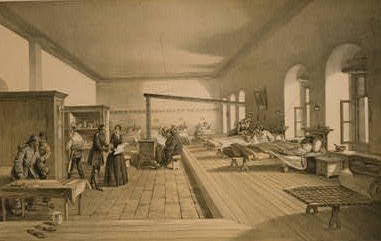by Nathaniel Roy

Bebek seminary bread became a point of interest on the British side—specifically for use in the hospital located in Scutari near Hamlin’s seminary.[1] The hospital itself was rampant with disease and death. As Christopher and Gillian Gill state “The extreme crowding on the wards was ideal for spreading typhus, typhoid, dysentery, and respiratory infections; one account noted that the beds were spaced 0.5 m apart.”[2] Originally the hospital was designed to help soldiers that were wounded in the war, but, more often than not, it caused harm.
The chief physician of this hospital, Dr. Mapleton, requested to meet with Hamlin regarding his bread. The negotiations resulted with Hamlin agreeing to provide bread for the hospital for three pence per pound or around four cents in American money.[3] After their talk, Hamlin and Dr. Mapleton wrote up a contract between Hamlin’s seminary and the British army hospital. Eventually the contract expanded substantially—from the beginning, only 250 pounds of bread were required, but, eventually, Hamlin was producing 6,000 pounds of bread for the hospital alone.
Hamlin’s bread was incredibly important during this time period because of the subsistence crisis that was rocking waves through Crimea and surrounding nations. Hamlin recounts that hundreds of soldiers were coming into the hospital from the front lines daily, and the treatment of them was incredibly poor.[4] The death rate was astronomical during this period due to disease and improper care of patients. Hamlin saw firsthand the atrocities of the hospitals, and the horrendous diseases that were rampant, not only there but on the front lines as well.
The subsistence crisis was one of the major impacts of the Crimean War. With military servitors streaming into the Black Sea the population of this small area virtually doubled overnight. With so many mouths to feed in such a small area, procuring food became increasingly difficult. Along with these difficulties, British and French sailors were among the worst hit by these shortages. Having no real source of provisions, they were forced to purchase from the coastal residents; however, after a threat from the Russian government, these residents elected to not sell as much anymore.[5] This inherent need for food is demonstrated in a letter from E.M. Lyons in which he describes sending out his Commander with a flag of truce and demanding the surrender of all vessels and corn stores for the army in Crimea so that they would be spared.[6] If the town refused, however, they were instructed to leave town immediately.[7] Food is necessary during war, and Hamlin’s bakery was sorely needed.
Not only did Hamlin see the food crisis and the horrendous conditions that the troops were put in, but he also dealt with a tremendous amount of corruption in the hospital. Specifically, Dr. Menzies and Mr. Rogers requested some of the profits that Hamlin earned from his bread contract.[8] Hamlin, though, was using all of the profits from the breadmaking to help raise the Armenians out of poverty, so he refused threats and blackmail.[9] However, Mr. Rogers did not want to hear that.[10]
Hamlin, soon, would figure out what this would mean when the conspiracies against his bread started. Because Hamlin was not sharing his profits with the leaders of the hospital, they purposely sabotaged his bread so he would have to pay a fine. Allegedly, the British blackmailers heated the bread so it would ferment, put baked bedbugs in the bread, and made worse bread and passed it off as Hamlin’s.[11] Of course, all of these conspiracies were all righted, and, after Hamlin threatened to stop making bread for the hospital, they stopped altogether. Dr. Menzies was found to be the head of all of these conspiracies, but little was done to him as a consequence.[12] Dr. Menzies was not removed because of these conspiracies, but he was removed because of his blatant disregard to the conditions in the hospital. According to the “Ministry to the sick and wounded soldiery in war times,” the air resembled “a dissecting chamber where corpses lie in all stages of putrefaction, nauseous in the extreme, and showing not only neglect, but downright incapacity on the part of medical attendants. Dr. Menzies was finally removed and in disgrace.”[13]
Notes
[1] Hamlin, My Life and Times, 325.
[2] Christopher J. Gill, and Gillian C. Gill, “Nightingale in Scutari: Her Legacy Reexamined,” Clinical Infectious Diseases 40, no. 12 (2005): 1800.
[3] Hamlin, My Life and Times, 327.
[4] Hamlin, My Life and Times, 329.
[5] Andrew Rath, The Crimean War in Imperial Context, 1854-1856, Palgrave Macmillan US, 2015. ProQuest Ebook Central, 83-84.
[6] John Grehan, and Martin Mace, British Battles of the Crimean Wars, 1854–1856, Despatches From the Front, Barnsley, South Yorkshire: Pen & Sword Military, 2014, 183.
[7] Grehan, and Mace, British Battles of the Crimean Wars, 1854-1856, 183.
[8] Hamlin, My Life and Times, 330.
[9]Hamlin, My Life and Times, 330.
[10] Hamlin, My Life and Times, 330.
[11] Hamlin, My Life and Times, 330-331.
[12] Hamlin, My Life and Times, 331.
[13] Editor in Chief, “Ministry to the sick and wounded soldiery in war times,” The Missionary Review of the World,
Vol. 13, No. 8, 578.